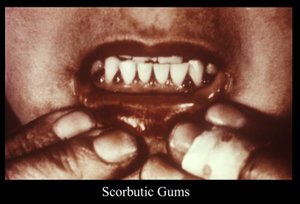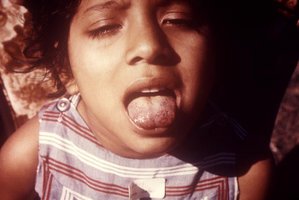Scurvy
Scurvy is a disease that results from insufficient intake of vitamin C and leads to the formation of livid spots on the skin, spongy gums, and bleeding from almost all mucous membranes. The spots are most abundant on the thighs and legs, and a person with the ailment looks pale, feels depressed, and is partially immobilized. Scurvy was at one time common among sailors whose ships were out to sea longer than perishable fruits and vegetables could be stored and by soldiers who were similarly separated from these foods for extended periods. more...
In infants, scurvy is sometimes referred to as Barlow's Disease, named after Sir Thomas Barlow (1845-1945), a British physician who first described it. Barlow's disease is different from Barlow's syndrome.
Scurvy is also known as Moeller's disease and Cheadle's disease.
Symptoms
Symptoms include:
- weakness
- joint pain
- black-and-blue marks on the skin
- gum disease
- spongy gums
this is all caused by the lack of fresh fruit and veg
It takes about three months of vitamin C deprivation to begin inducing the symptoms of scurvy. Untreated scurvy is always fatal, but since all that is required for full recovery is the resumption of normal vitamin C intake, death by scurvy is rare in modern times.
History
Scurvy was probably first observed as a disease by Hippocrates. In the 13th century the Crusaders suffered from scurvy frequently, and it has inflicted terrible losses on both besieged and besieger in times of war. Scurvy was one of the limiting factors of marine travel, often killing large numbers of the passengers and crew on long-distance voyages. It even played a significant role in World War I.
The British civilian medical profession of 1614 knew that it was the acidic principal of citrus fruit which was lacking, although they considered any acid as acceptible when Ascorbic Acid (Vitamin C) was unavailable. In 1614 John Woodall (Surgeon General of the East India Company) published his book "The Surgion's Mate" as a handbook for apprentice surgeons aboard the companies ships. In it he describes scurvy as resulting from a dietry deficiency. His recommendation for its cure is Fresh Food or, if not available, Oranges,Lemons,Limes and Tamarinds, or as a last resort, Oil of Vitriol. (Sulphuric Acid)
However, it was not until 1747 that the treatment and prevention of scurvy by supplementation of the diet with citrus fruit such as lemons and limes was introduced into the British Navy by James Lind.
The plant known as "scurvy grass" acquired its name from the observation that it cured scurvy, but this was of no great help to those who spent months at sea. During sea voyages, it was discovered that sauerkraut was of use in preventing scurvy. In the Royal Navy's Arctic expeditions in the 19th century, for example, it was widely believed that scurvy was prevented by good hygiene on board ship, regular exercise, and maintaining the morale of the crew, rather than by a diet of fresh food, so that Navy expeditions continued to be plagued by scurvy even while fresh meat was well-known as a practical antiscorbutic among civilian whalers and explorers in the Arctic. At the time Robert Falcon Scott made his two expeditions to the Antarctic in the early 20th century, the prevailing medical theory was that scurvy was caused by "tainted" canned food. It was not until 1932 that the connection between vitamin C and scurvy was established.
Read more at Wikipedia.org



